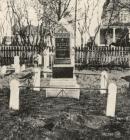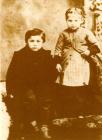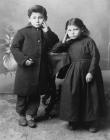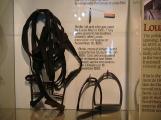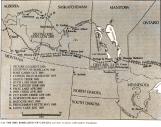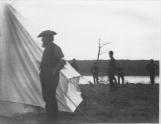2
Louis Riel was born October 22, 1844 in the Red River Settlement and was the oldest of eleven children. In 1864 he left his training for the priesthood and by 1868 was the leader of the Métis demands for land rights in Red River. On November 23, 1869 Riel established a provisional government and in the Manitoba Act of 1870 the Métis land rights were granted. This was a great success for him but during this time he had also had Thomas Scott executed. Fearing an arrest, Riel fled the country and, even though he was elected to Parliament for three consecutive years; he never sat in the Commons. He had also become obsessed with the notion in which he was the spiritual leader of the Métis people.3
Marguerite Monet married Louis Riel in a civil ceremony and had two children, Jean and Angelique.1885

4
From March 1876 until late 1877 Riel spent time in Quebec asylums due to a mental illness, Megalomania. When he was released he decided to lead a quiet life in Montana where he became a trader, interpreter and teacher. In 1881 he married Marguerite Monet and became an American citizen in 1883. They had two children Jean born May 4, 1882 and Angelique born September 17, 1883. His wife died May 1886 of Tuberculosis and Angelique in 1897 of Diptheria. Jean went on to become a civil engineer and married Laura Casault in 1908 and died that same year in a buggy accident.8
In 1884 Gabriel Dumont and a group of men invited Riel to Batoche where he could lead the Métis.At first the settlers welcomed Riel with his moderate viewpoints and support of the December 16, 1884 petition. With no response to the petition Riel decided to stay and fight for the Métis cause. During this time he started preaching his own theology where he was the spiritual leader of the Métis people. This more radical form of leadership lost Riel some support of the cause, leaving him only the most radical followers.
Concerned with the movement of North West Mounted Police arriving in the West Riel decided to set up a provisional government in St. Laurent, copying what had worked in Manitoba. He also agreed to let the Métis arm themselves and Gabriel Dumont led a group of men to Duck Lake where they hoped to acquire arms and ammunition from Mitchell's store. It was Dumont's group of men that met Superintendent Crozier's men headed to Duck Lake for the same purpose of obtaining supplies.
With the Battle of Duck Lake taking place around him, Riel was armed with only a crucifix. After the battle had ended, Riel ordered that the dead NWMP and volunteers be left in a log cabin and that the wounded NWMP be tended to. When Dumont proposed ambushing them on their retreat to Prince Albert Riel replied "For the love of God, kill no more of them."
11
On May 16, after the Battle of Batoche, Riel surrendered to General Middleton and the next day they started for Regina where Riel would stand trial. Riel was tried for high treason and on November 16, 1885 was hung.12
This is a photo of the monument set up on Riel's grave in St. Boniface.1890
Graveyard in St. Boniface, Manitoba, Canada
